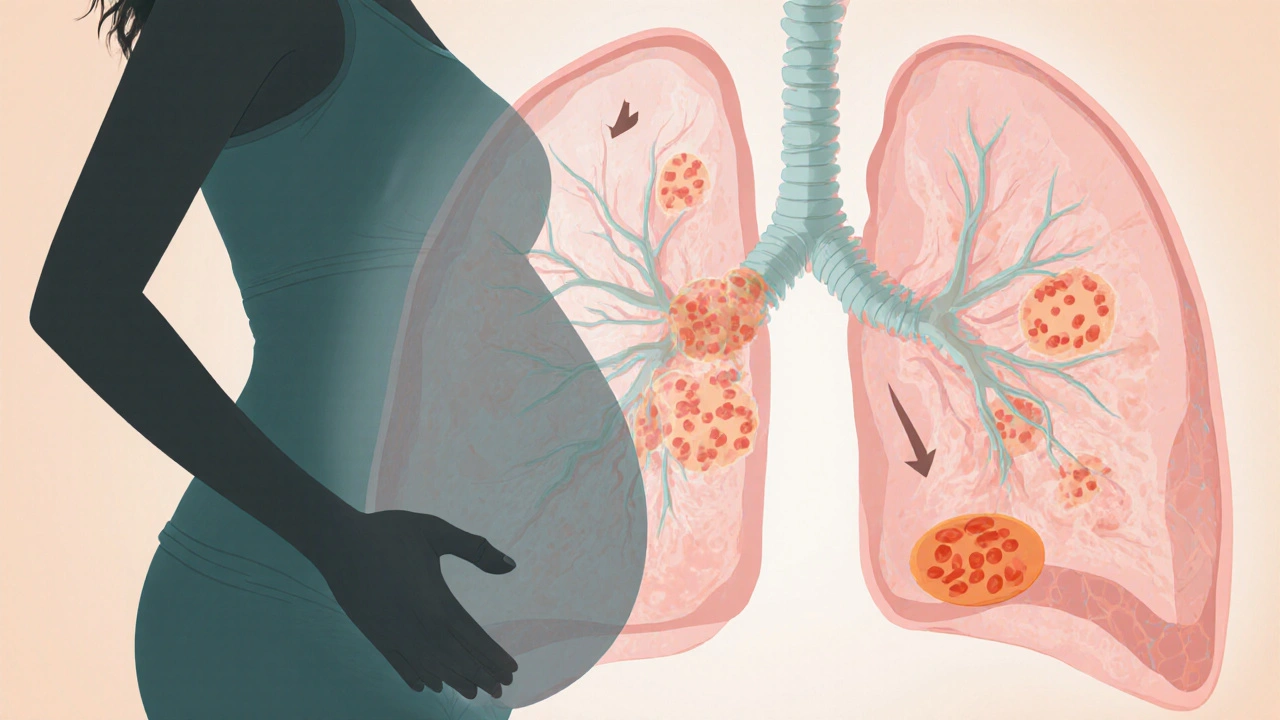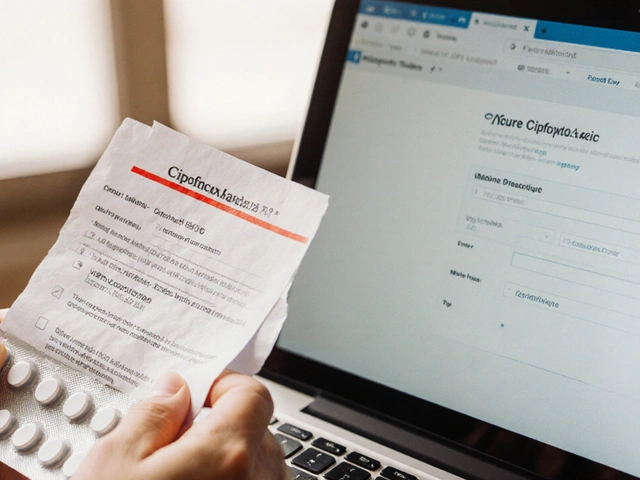Pregnancy & Pneumonia Risk Assessment Tool
- ✓ Persistent cough producing green or yellow sputum
- ✓ Fever ≥ 38°C (100.4°F) lasting more than 24 hours
- ✓ Shortness of breath even at rest
- ✓ Chest pain that worsens with deep breaths
- ✓ New-onset fatigue or confusion
- Get the flu and pneumococcal vaccines early in pregnancy
- Maintain good hand hygiene and respiratory etiquette
- Eat a nutrient-rich diet and stay hydrated
- Avoid smoking and secondhand smoke exposure
- Attend regular prenatal visits for monitoring
When a pregnant woman contracts Pneumonia is a lung infection that inflames the air sacs, filling them with fluid or pus, the stakes feel higher. Hormonal changes, a higher oxygen demand, and a slightly suppressed immune system mean the illness can affect both mother and baby more seriously than in the general population. This guide breaks down pneumonia pregnancy risks, shows how to spot trouble early, and lays out proven prevention strategies so you can protect yourself and your little one.
Quick Takeaways
- Pregnancy raises the chance of severe pneumonia by up to 30% because of reduced lung capacity and immune shifts.
- Key warning signs are persistent cough, fever>38°C, rapid breathing, and chest pain that doesn’t improve in 48hours.
- Both the seasonal influenza vaccine and the pneumococcal vaccine are safe during any trimester and cut hospitalization risk by half.
- If you suspect pneumonia, get a chest X‑ray (low‑dose is safe) and start antibiotics promptly under obstetric guidance.
- Good hand hygiene, nutrition‑rich diets, and regular prenatal check‑ups are the simplest yet most powerful defenses.
Understanding Pneumonia During Pregnancy
Pregnancy brings a 10-20% increase in tidal volume and a 30% rise in oxygen consumption. The diaphragm is pushed upward, leaving less room for the lungs to expand. These physiological tweaks mean that any infection that fills the alveoli with fluid reduces the already‑tight oxygen reserve even further.
In addition, progesterone‑driven changes cause the immune system to tilt toward a “tolerant” state, which helps the body accept the fetus but also makes it easier for bacteria and viruses to settle in the lungs.
Because of these factors, a pregnant woman with pneumonia often experiences faster progression to hypoxia, a higher need for supplemental oxygen, and a greater likelihood of pre‑term labor.
Why Pregnancy Increases the Risk of Severe Illness
Three main mechanisms drive the elevated risk:
- Reduced Lung Capacity: The growing uterus limits diaphragmatic movement, decreasing maximal inspiratory pressure by up to 15% in the third trimester.
- Immune Modulation: Levels of Th1‑type cytokines fall, while Th2‑type rise, which can blunt the early antibacterial response.
- Higher Metabolic Demand: The fetus consumes about 20mL of oxygen per minute, so any drop in maternal arterial oxygen quickly translates to fetal hypoxia.
Clinical studies from the UK and US between 2018‑2023 show that pregnant patients with community‑acquired pneumonia have a 1.7‑fold higher odds of ICU admission compared with non‑pregnant women of the same age.
Recognizing the Symptoms Early
Early detection can mean the difference between a short course of oral antibiotics and an emergency delivery. Watch for these red flags:
- Persistent, worsening cough that produces green or yellow sputum.
- Fever ≥38°C (100.4°F) lasting more than 24hours.
- Shortness of breath even at rest, or a respiratory rate>22 breaths per minute.
- Chest pain that worsens with deep breaths.
- New‑onset fatigue, confusion, or a feeling that you can’t catch your breath.
If any of these appear, call your obstetrician or go to the nearest urgent‑care centre. A low‑dose chest X‑ray is considered safe in pregnancy, delivering less than 0.01mSv of radiation-well below the threshold for fetal harm.

Treatment Options and What’s Safe for Baby
Once pneumonia is confirmed, the goal is rapid eradication of the pathogen while protecting the fetus. Most clinicians follow these steps:
- Antibiotic Choice: Antibiotics such as amoxicillin, erythromycin, or ceftriaxone are classified as Category B, meaning animal studies show no risk and there are no well‑controlled studies in pregnant women.
- Supportive Care: Supplemental oxygen to keep maternal SpO₂≥95% and adequate hydration. Intravenous fluids are preferred if oral intake is limited.
- Monitoring: Daily fetal heart rate checks, maternal temperature logs, and repeat chest imaging if symptoms worsen.
In rare cases where the infection is caused by atypical pathogens (e.g., Mycoplasma or Legionella), macrolides remain the best‑studied option. Fluoroquinolones are avoided because of potential cartilage toxicity in the developing fetus.
Prevention Strategies That Really Work
Preventing pneumonia before it starts is far easier than fighting it once it’s established. Below are the most evidence‑backed tactics.
Vaccination - The Cornerstone
Two vaccines stand out:
- Influenza vaccine is an inactivated, quadrivalent shot that protects against the most common seasonal strains. Studies from the CDC (2022) show a 55% reduction in hospitalizations for pregnant women who received the flu shot.
- Pneumococcal vaccine (PCV13 or PPSV23) guards against Streptococcus pneumoniae, the leading bacterial cause of pneumonia. The UK’s Joint Committee on Vaccination and Immunisation (JCVI) recommends it for pregnant women with chronic heart, lung, or kidney disease.
Both vaccines are safe in any trimester and do not contain live viruses, so they can’t cause infection in the fetus.
| Vaccine | Target Pathogen | Recommended Trimester | Effectiveness in Pregnancy | Common Side‑effects |
|---|---|---|---|---|
| Influenza (inactivated) | Influenza viruses (A/B) | Any trimester | ≈55% reduction in severe flu cases | Soreness at injection site, low‑grade fever |
| Pneumococcal (PCV13/PPSV23) | Streptococcus pneumoniae | Second or third trimester (or pre‑pregnancy) | ≈70% reduction in invasive pneumococcal disease | Injection site pain, mild fatigue |
Hand Hygiene and Respiratory Etiquette
Simple habits cut transmission risk dramatically. Wash hands with soap for at least 20seconds, especially after coughing, sneezing, or handling public surfaces. When you’re sick, wear a surgical mask and keep a distance of at least 1meter from others.
Nutrition and Immune Support
A balanced diet rich in vitaminC, vitaminD, zinc, and omega‑3 fatty acids boosts the maternal immune system. Prenatal supplements that include 1000IU of vitaminD daily have been linked to a 20% lower incidence of respiratory infections.
Avoiding Smoke and Pollutants
Secondhand smoke raises pneumonia risk by 2‑fold. If you live with smokers, create smoke‑free zones, and consider an indoor air purifier with a HEPA filter.
Regular Prenatal Visits
Routine check‑ups give clinicians the chance to screen for early signs of respiratory illness, update immunizations, and reinforce preventive measures.
When to Seek Immediate Medical Attention
If you notice any of the following, treat it as an emergency:
- Maternal oxygen saturation dropping below 95% (use a pulse oximeter if you have one).
- Persistent fever for more than 48hours despite acetaminophen.
- Rapid heart rate (>120bpm) or sudden increase in respiratory rate.
- Decreased fetal movements or abnormal fetal heart rate patterns.
- Severe chest pain that radiates to the back.
Call emergency services or go straight to the obstetric emergency department. Early aggressive treatment can prevent both maternal ICU admission and pre‑term birth.
Key Takeaways for Expectant Mothers
Summarizing the most actionable points:
- Get the flu shot and, if you have risk factors, the pneumococcal vaccine early in pregnancy.
- Practice diligent hand hygiene and wear masks during flu season.
- Stay hydrated, eat a nutrient‑dense diet, and avoid secondhand smoke.
- Know the warning signs of pneumonia and don’t wait to call your healthcare provider.
- If diagnosed, follow the prescribed antibiotic regimen and attend all follow‑up appointments.
Frequently Asked Questions
Can I get a chest X‑ray while pregnant?
Yes. A low‑dose chest X‑ray delivers less than 0.01mSv of radiation, far below the level that could harm the fetus. The benefit of accurate diagnosis outweighs the minimal risk.
Are antibiotics safe for my baby?
Most antibiotics used for community‑acquired pneumonia, such as amoxicillin and erythromycin, are classified as Category B - they have not shown fetal risk in animal studies and are commonly prescribed during pregnancy.
Should I avoid the flu vaccine if I’m in my first trimester?
The inactivated flu vaccine is safe at any stage of pregnancy. Getting it early protects both you and the newborn during the first few months after birth when the infant’s immune system is still developing.
What if I have asthma - does that change the prevention plan?
Asthma adds to the risk of severe pneumonia. You should receive the flu and pneumococcal vaccines, keep your inhaler handy, and discuss a personalized asthma action plan with your obstetrician.
Can pneumonia cause a miscarriage?
Severe, untreated pneumonia can lead to low oxygen levels that jeopardize the placenta, increasing the risk of miscarriage or pre‑term labor. Prompt treatment dramatically lowers that risk.







Dustin Richards
October 1, 2025 AT 12:17 PMThanks for pulling all this together; it’s a lot to take in. I appreciate how you laid out the risk factors step‑by‑step. For anyone reading, keep an eye on those fever and breathing changes, they’re easy to miss when you’re already exhausted. And don’t forget to schedule that flu shot early – it really does make a difference.
Vivian Yeong
October 9, 2025 AT 14:44 PMThe guide is thorough, but the vaccination section could be condensed; most readers will skim past the table.
Ashleigh Connell
October 17, 2025 AT 17:10 PMWow, this is like a one‑stop shop for expectant moms! The checklist of symptoms is crystal clear, and I love the practical tips about hand hygiene and diet. It even throws in a handy table that makes the vaccine info pop. Keep sharing these lifelines – they’re priceless.
Erin Knight
October 25, 2025 AT 19:37 PMHonestly, the article reads like a brochure that never left the PR department. It’s full of buzzwords but lacks real depth on treatment protocols.
Kavita Jadhav
November 2, 2025 AT 21:04 PMThis piece hits the mark on what pregnant women need to know, especially the part about oxygen levels. I’d add that anyone with asthma should also keep a rescue inhaler on hand and coordinate with their OB‑GYN. Prevention is key, so the vaccine reminders are spot on.
Tony Halstead
November 10, 2025 AT 23:30 PMReading through this guide reminded me how interconnected physiology and infection risk truly are, especially during pregnancy.
The author does an excellent job breaking down the three main mechanisms – reduced lung capacity, immune modulation, and higher metabolic demand – and ties each to clinical outcomes.
By explaining how the diaphragm’s upward shift limits inspiratory pressure, they give readers a concrete image of why every cough matters.
The discussion of Th1 versus Th2 cytokine shifts is concise yet informative, highlighting why bacterial pathogens can gain a foothold.
Moreover, the statistics from recent UK and US studies provide a solid evidence base without overwhelming the layperson.
I also appreciate the clear warning signs listed in bullet points; they serve as a quick reference that can be bookmarked.
The inclusion of low‑dose chest X‑ray safety reassures many who fear radiation exposure.
When it comes to treatment, the step‑by‑step antibiotic recommendations are spot‑on, emphasizing Category B drugs that have been vetted for fetal safety.
The advice to avoid fluoroquinolones is a crucial reminder that not all antibiotics are created equal for pregnant patients.
Prevention strategies are thorough – the vaccination section is especially strong, detailing both flu and pneumococcal vaccines with their timing and efficacy.
The lifestyle tips, from nutrition to smoke avoidance, round out a holistic approach that feels both realistic and actionable.
One area that could be expanded is mental health support, as anxiety often spikes when dealing with respiratory illness during pregnancy.
Overall, the guide balances scientific rigor with compassionate tone, making it a valuable resource for expectant mothers and clinicians alike.
Keep up the great work, and consider adding a quick printable summary for clinic waiting rooms.
Future updates could also cover emerging variants of respiratory viruses and their specific risks.
leo dwi putra
November 19, 2025 AT 01:57 AMImagine the panic of a pregnant mom hearing that her lungs are filling with fluid – it’s like a thriller playing out inside her chest! The author nails that drama, but I wish there were more personal stories to really feel the stakes. Still, the facts are solid and the prevention checklist reads like a battle plan.
Krista Evans
November 27, 2025 AT 04:24 AMGreat rundown! Stay proactive, and you’ll keep both you and the baby breathing easy.
Kimberly Newell
December 5, 2025 AT 06:50 AMthis is super helpful lol i woudnt have known about the low dose xray safety thing otherwise. thx for the tips!
Drew Burgy
December 13, 2025 AT 09:17 AMSure, because “buzzwords” are the biggest threat to maternal health.